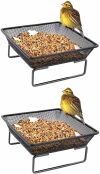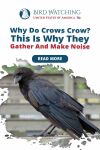
What’s This Post About?
Blue jays are one of the songbirds that are native to North America.
As the name indicates, they have a bright blue plumage and are known for being beautiful but highly aggressive as well. They are also quite large as compared to other songbirds.
You may see these beautiful and intelligent birds throughout the year as they don’t move to the south when it’s cooler.
Many people search for their life span and how long they manage to live; we have put together this post to help you identify the answer.
The approximate life span of a blue jay is 7 years in the wild; however, the longest living blue jay had a 26 years lifespan. Blue Jays in their natural habitat may survive for longer, but their life is often cut short due to predators. On the contrary, and in captivity, a blue jay might live a shorter life.

How Long Does a Blue Jay Live?
The actual lifespan of blue jays can vary according to the environmental conditions they have to face. However, blue jays in the wild can live for approximately seven years.
At the start of the life cycle, hatchlings of blue jays live with their parents. After the first few months, blue jays will start to live independently once the fall season arrives.
They have a very similar life cycle to every other bird, and an average blue jay will mature at the age of 1 year. Once they develop, they will immediately find a mate.
Like cardinals and various other birds, blue jays also mate for life and remain with the same partner for the rest of their lives until one of them does not die.

Which Season do Blue Jays Lay Eggs In?
Breeding seasons of blue jays include spring and summer, in which they lay eggs. The few months they pick are between March and July, and the peak season they choose for breeding is at the end of May.
They have average-sized nests that can contain about 3-7 eggs. The female blue jay can raise two broods every year.
The incubation period for each egg is about 18 days which is quite a long time to wait until the egg hatches. Throughout this incubation period, it is the female blue jay’s responsibility to keep eggs warm.

The male blue jay will keep on returning to the nest to feed the female meanwhile she is nesting. He will also patrol around the nest to keep it protected from predators.
Warning
Blue jays might seem calm and friendly; however, they become very aggressive during their breeding season and can attack humans if they try to stand too close to their nesting area.
What Does a Blue Jay’s Egg Look Like?
Most birds have white or pale-colored eggs; however, the blue jay is one of the few birds with colored eggs. It has light blue color eggs along with some green color patches and hues.
However, that is not the only color that a blue jay egg is in. They can also be found in different colors like yellow, along with a few grayish spots.

On average, after about 16 to 18 days, a blue Jay egg will hatch. Mostly, the female blue jay will incubate eggs; however, both parents will contribute to the incubation of the eggs in some cases.
Once the eggs hatch, both the parents will bring the food for the hatchlings. After about 17 to 21 days, the hatchlings will leave the nest to live on their own.
Cool Fact
Blue jays are one of those interesting birds that can mimic the sound of their predatory raptors. They will mimic the sound of the predator to check if there is any predator nearby.
What Type of Habitat Do Blue Jays Live In?
Blue jays are most commonly found in the Central and Eastern areas of the United States. However, they are also found in Southern Canada.
These beautiful and intelligent birds are primarily found in coniferous and mixed forests. However, they are also found in various parks and Suburban residential areas.
These beautiful songbirds can be one of the guests of your backyard feeders.
Most of these blue-colored birds are permanent residents of their area; however, some will end up being a part of a flock to migrate southwards in specific seasons.

Each flock may contain a range of blue jays from between 5 to 250. The migratory behavior of blue Jay is relatively unknown and a mystery for most.
Interesting Fact
Blue jays might migrate one year and then decide to stay next year in the same place; however, the very next year, they might migrate again. Their migratory behavior is still unknown. Some people conclude that they only migrate when their food sources become scarce, and they have to face harsh weather conditions due to winters.
What Do Blue Jays Prefer Eating?
Blue jays have this particular preference for a couple of food items, and they are very fond of eating peanuts especially.
These delicate and beautiful-looking blue-colored birds have strong black bills capable of cracking hard nuts and acorns.
Hence, they mostly prefer eating nuts and acorns; however, they also like to eat grains, seeds, berries, and corn.
Other than this, they might also eat peanuts and insects. Due to their large size, they often dominate bird feeders, making other smaller birds fly away.

They may sometimes force away the smaller-sized birds from the bird feeders. However, most of the time, they behave gently by waiting for their turn on the bird feeders.
They then munch on seeds along with their similar-sized birds like woodpeckers. One of the rare things that blue jays do include eating eggs and nestlings of smaller birds.
How to Attract Blue Jays to Your Garden?
If you want to attract blue jays, then you need a feeder that is quite large and has a supportive design to host blue jays.
The most common feeder they get attracted to is ground bird feeder because they like to feed from the ground. Moreover, you can also try placing your bird feeder near a covered area such as a tree or some shrubbery place.
Explore the Wosibo Platform Ground Bird Feeder. It has an average rating of 4.3 out of 5.
WOSIBO Platform Ground Bird Feeder
The minimalist design creates the maximum space to allow many birds to feed on the ground at once. And the metal rust-free mesh tray allows the water to easily drain out and keep seeds dry
Most of the time, blue jays are not very friendly and will not approach a bird feeder that has humans near it.
To make them feel more comfortable and attract to your garden’s bird feeder, you might have to be careful, including staying away from the feeder and watching them through the windows.
Since these blue color birds are more fond of peanuts and corn, try putting such items in the bird feeder.
Pro-Tip
Maintaining your bird feeder can also be very healthy and appealing for these birds. Moreover, you can make sure that you add a water source for these birds nearby so that they can drink easily and enjoy a good bath.
What are The Mating Habits of Blue Jays?

Blue jays form monogamous pairs, and they mate for life with the same bird. They are mostly very easy-going about picking their nesting location and can pick any appropriate tree or large-sized brush.
They can even pick up places like mailboxes and older nests of some other similar-sized birds if they find them in suitable spots.
They usually build their nest at the height of about 3 to 10 meters on trees. The shape of their nest is cup-like, and it comprises small roots, plant materials, twigs, bark strips, feathers, and cloth.
Both of these birds from a pair will contribute to the nest making; however, once the incubation period starts, most of the job of incubation is of the female blue jay.
What is the Population of Blue Jays?

It is hard to know the accurate population size of any species; however, on average, they are said to be about 22,000,000 in population.
However, the good part is that there is no specific threat to their species, and they are not on the red list of IUCN because of being stable in number.
They have also been found to breed healthily around various areas of the United States.
Fun Fact
These birds will hide the seed and nuts into the soil by burying them; however, they forget about them, which helps to disperse the seeds in the ecosystem.
How Can You Differentiate Between a Male And a Female Blue Jay?
Most of the birds have apparent differences among their male and female counterparts. However, in Blue Jays, it gets challenging to identify as they are almost identical.
Both of these sexes have similar patterns and colors in their wings, making them look identical and hard to differentiate. However, there is still some difference between these birds, which helps to differentiate them.

The only difference between a male and female blue jay is between their size. Male blue jay has a slightly bigger size than the female; however, you can only identify this when they are gathered up in a flock.
Keep Reading
Regardless of whether you reside in the United States or any other part of the world, knowing about blue jays is something that fascinates many.
For those looking to identify their lifespan, a blue jay will live approximately 7 years, going up to 26 years in the best-case scenario.
Although blue jays are quite distant, and they might not be the most suitable bird for petting, you can somehow get attached to them when they visit your backyard every day.
Feeding them with sufficient food can make them live longer than the approximate range.
You can feed blue jays with their favorite food, which includes corn and peanuts. If you wish to know more, here’s a fun post you can read on why blue jays are blue.
Why Are Blue Jays Blue? Their Cells Hide a Little Secret
Have you ever wondered why some birds are blue? To find out the specific reason behind why blue jays are blue, read below.

By David A. Swanson
Bird Watching USA
My name is David and I'm the the founder of Bird Watching USA! I started Bird Watching with My father-in-law many years ago, and I've become an addict to watching these beautiful creatures. I've learnt so much over about bird watching over the years that I want to share with the world everything I know about them!

David A. Swanson
Bird Watching USA
My name is David and I'm the the founder of Bird Watching USA! I started Bird Watching with My father-in-law many years ago, and I've become an addict to watching these beautiful creatures. I've learnt so much over about bird watching over the years that I want to share with the world everything I know about them!










